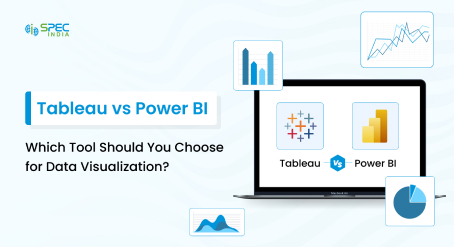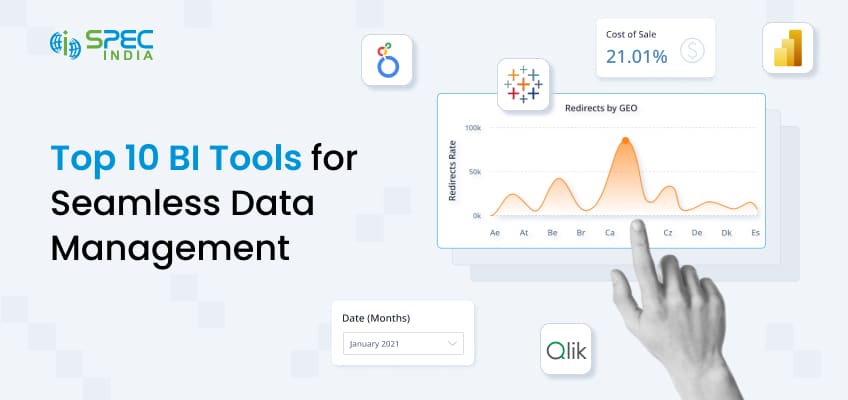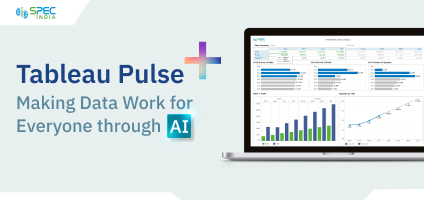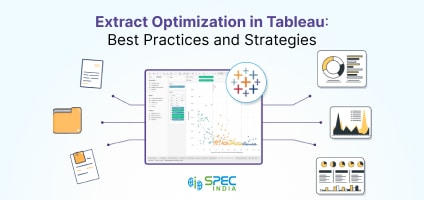Tableau vs Excel: Overview, Comparison And Differences
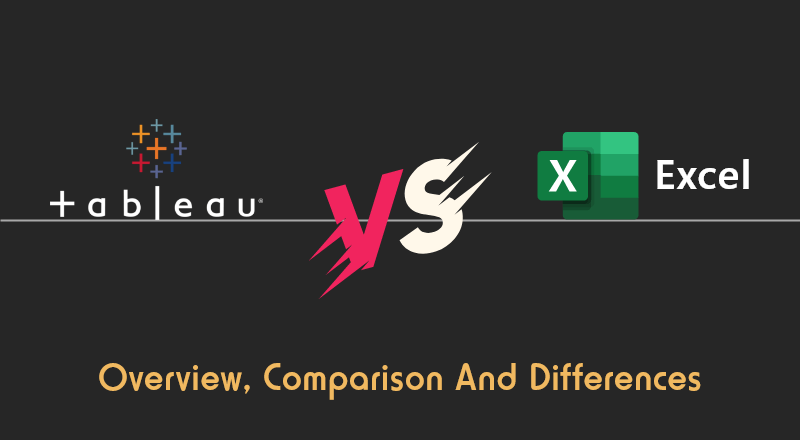
Data is the crux for all businesses today, be it any geography, size, or segment. In a world ruled by data, analysis of data and extracting the best information is vital. Two data analysis tools – Tableau and Excel are often compared and have a lot in common, but have their own characteristics too. Excel has been around for a long time, but Tableau is comparatively a newcomer that has taken the data analytics forum by storm.
Tableau has been one of the most powerful BI tools and has helped users analyze their data through dashboards and reports. Tableau has been a revolution for data scientists, analysts, and business owners by offering insightful information on the heaps of data that organizations possess. Excel may not look as powerful as Tableau when it comes to visualization, but when it comes to data creation, multi-layered calculations, and multiple operations on data, Excel stands strong.
There are wide opinions that Tableau is going to replace Excel, and others say that Excel cannot be replaced. Thousands of organizations are using Tableau to extract the best out of their data, and Excel is a name relevant to almost all users, be it personal devices or professional ones. There are organizations like Elaura, Seagate, OptumHealth, etc., that are transforming Excel data into Tableau format for better decision-making.
Before comparing the two, let us understand the basics of both:
What is Tableau?
Tableau Software is an American interactive data visualization software company focused on business intelligence. – Wikipedia
BI and analytics users leverage Tableau for data visualization purposes, for users to look at and understand data in such a way that helps them to make necessary business decisions. All types of plotting, graphs, charts, etc. can be done by users themselves, instead of relying on the IT staff, without much programming aid. Tableau has been in existence since 2003 and was acquired by Salesforce in 2019.
As an analysis and spreadsheet tool, it facilitates Excel users to retain their spreadsheets and at the same time, enhance their data with visual representations and dashboards, delving deeper into data. The Tableau range of products includes Tableau Desktop, Tableau Server, Tableau Online, Tableau Reader, Tableau Mobile, Tableau CRM, etc.
Collaboration and sharing, data sources in Tableau, data visualization dashboard, drag and drop integration, external service integration, data connectors, advanced visualization, robust security, maps, mobile view, predictive analytics, etc., are some of the key features of Tableau that have been attracting users and continue to do so.
Tableau connects seamlessly to Excel spreadsheets to make the analysis of data easy and quick. It helps Excel users retain their spreadsheets, enhancing competence for data analysis to offer the creation of live visualizations that simplistically showcase information.
Organizations using Tableau are – Nike, US Foods, Coca-Cola, Acxiom, DraftKings, Skype, Snap Finance, Phillips 66, Citigroup, The New York Times, etc.
What is Excel?
Microsoft Excel is a spreadsheet developed by Microsoft for Windows, macOS, Android, and iOS. It features calculation, graphing tools, pivot tables, and a macro programming language called Visual Basic for Applications. – Wikipedia
Excel is leveraged by organizations, big and small, for data organization, financial analysis, creation of budgets by making graphs, and laying out formulas. Through this, tax/payroll/revenue calculation can be done. Excel forms part of the Microsoft Office suite of software and has been in sharp existence for three decades.
As a spreadsheet too, Excel has been the most used tool on a personal front as well as a business front. It is easy for users to define their customized formulas and extract their time-based reports.
Data filtering and sorting, password protection, formula auditing, built-in formulas, creation of charts, automatic editing of results, advanced filtering, conditional formatting, Pivot tables, absolute references, filters, etc., are the main features of Excel through which it has been attracting users across the globe.
Organizations using Excel at a professional level are – Samsung Electronics, Total, AXA Group, United Parcel Service Inc., Carrefour S.A., and many more.
Tableau vs Excel: An Extensive Comparison
As we observe the difference between Excel and Tableau, it is important to state that they both have certain points in common, too. They both are used for data analysis and can extract information like the users’ needs, but in different ways.
| Parameters |
Tableau |
Excel |
| Purpose |
Visualization and representation of insights from raw data |
Quick calculations, organization, and formatting of data |
| Tool Type |
Data visualization tool |
Spreadsheet tool |
| Data Size |
Ideal for large datasets, Big Data |
Ideal for small to medium-sized datasets |
| Performance |
Efficient and fast in performance, even as the data size increases |
Tough to offer great performance when data increases |
| Data Sources |
Easy connection with varied sources in real-time |
Plug-ins are necessary for non-Excel sources |
| Key Features |
User-friendly, quick, and interactive visualization. Powerful and intuitive. Data joining and merging. Manipulation of large sets. |
Descriptive and manipulative statistics. Multi-layered calculations on data. Ad hoc data management. Using inbuilt functions. |
| Application Users |
Data scientists, data analysts |
Data analysts, developers, ETL DBA |
| Data Exploration |
Exploring data through interactive dashboards |
Limited exploration of data through spreadsheets |
| Display of Data |
Through pictorial or graphical representation. With dashboards to spot patterns, trends, etc. Visual reports are available right from the beginning without any filtration. |
Through spreadsheets in a tabular format, through cells. With graphs, charts, etc., to highlight an insight. Filtration is needed at the cell level, after which visualization is created. |
| Ease of Use |
No programming knowledge required |
Knowledge of customized functions is needed |
| Data Ingestion |
Live connection link to data sources saves a lot of time |
Obtaining from other sources is time-consuming |
| Data Visualization |
Huge range of customized inbuilt charts |
Simple and restricted Excel charts |
| Sharing of Dashboards |
Creating and sharing a dashboard is difficult |
Dashboard sharing is easy to handle |
| Security Control |
Data security is ensured through many options without scripting |
Limited security controls are offered for data |
| Application Integration |
Integrates seamlessly with 250+ applications |
Integrates seamlessly with 60+ applications |
| Formulas and Calculations |
Easy and more powerful to create customized formulas |
Involves the creation of macros and some level of programming |
| Data Blending |
Easier in Tableau by importing from different sources and adding relationships |
A little complicated in Excel by writing formulas and then computing them accordingly |
| Drilling Down of Data |
Users can freely explore data by drill-down and data blending features. Trends and correlations can also be spotted. |
Drill-down data is less flexible, as users need to move through the tabular formats. Exploring information is complicated. |
| Automatic Refresh |
Automatic refreshing of Tableau applications is easy, as it is intuitive, and recurring processes can be created. Custom formulas can also be applied. |
Automatic refreshing of Excel worksheets requires the creation of macros or manual programming methods, which can become difficult. |
Benefits of Tableau Over Excel
While Excel has long been the go-to tool for spreadsheets and basic data analysis, the evolution of data analytics and business intelligence (BI) has shifted the spotlight to more advanced tools like Tableau.
Tableau is not just a data visualization platform, but it’s a powerful BI tool that enables interactive dashboards, real-time insights, and enterprise-grade scalability. Here are the main reasons why businesses across industries are choosing Tableau over Excel.
- Superior Data Visualization
Tableau is designed specifically for advanced data visualization. Unlike Excel, which offers basic charts and static graphs, Tableau provides dynamic, interactive dashboards and a wide array of visualization options, including heat maps, treemaps, and geographic maps. This allows users to explore data in depth and uncover hidden trends or patterns with ease.
- Handling Large Datasets
Excel has a row limit (around one million rows) and can become slow or unresponsive with large datasets. Tableau, on the other hand, is optimized for handling big data efficiently, making it ideal for organizations dealing with extensive data volumes.
- Interactive and User-Friendly Interface
Tableau’s drag-and-drop interface makes it accessible even for non-technical users. It enables quick filtering, drilling down into data, and real-time updates, which are not as seamless in Excel.
- Integration with Multiple Data Sources
Tableau supports integration with a wide range of data sources, including databases, cloud services, and even programming languages like Python and R. This flexibility allows users to combine and analyze data from various platforms effortlessly.
- Advanced Analytics Capabilities
Tableau offers advanced analytics features, including predictive analytics and trend analysis, which are particularly beneficial when integrated with R or Python. Excel, while robust for basic calculations and data modeling, lacks these advanced functionalities.
- Automated Data Preparation
Tableau Prep, an integrated tool, streamlines data cleaning and transformation, reducing manual effort compared to Excel’s more manual data preparation processes.
- Mobile and Cloud Compatibility
Tableau dashboards can be accessed and interacted with on mobile devices or via the cloud, making it easier for teams to collaborate and share insights anytime, anywhere.
- Time-Saving and Efficient Updates
Uploading new data and updating visualizations is faster in Tableau, saving analysts significant time compared to Excel, especially when working with complex or frequently changing data.
Tableau vs Excel: Which Serves The Purpose?
No doubt, both Tableau and Excel are great assets to the family of data tools, and they both look similar but have very different objectives. The objective of the organization and the key reasons are good enough to decide on which one to pick. The types of reports needed by the organization, the frequency of creation of those reports, and the allocated budget are some of the major factors that will help decide which one to choose.
Tableau is a data analytics and visualization tool whereas Excel is a spreadsheet tool. When it comes to handling small to medium-sized organizational data, Excel may serve the purpose, especially if it is all about calculations and formulas. But, when it comes to handling a huge bulk of information, just like Big Data, Tableau is perfect since it showcases data in a visually appealing manner with complete data insight. It is viable for Tableau to create a seamless data source connection with Excel and extract data from it. Finally, it is the organization’s call!
SPEC INDIA is your trusted partner for AI-driven software solutions, with proven expertise in digital transformation and innovative technology services. We deliver secure, reliable, and high-quality IT solutions to clients worldwide. As an ISO/IEC 27001:2022 certified company, we follow the highest standards for data security and quality. Our team applies proven project management methods, flexible engagement models, and modern infrastructure to deliver outstanding results. With skilled professionals and years of experience, we turn ideas into impactful solutions that drive business growth.



